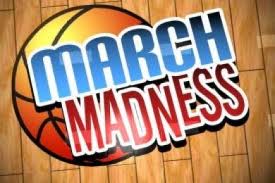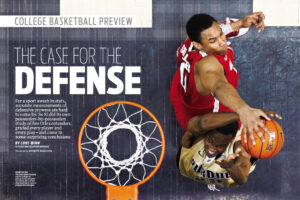College Basketball’s Top Defensive Teams At Tournament Time
The NCAA Tournament is less than 10 days away, and the College Conference Tournaments (CCT’s) hit their stride this week with the power conferences in action. In past season’s, I’ve updated defensive stats and the top defensive teams in February in the final weeks of the regular season.
But this season with more games cancelled and rescheduled due to the pandemic, I’ve updated the stats for you to review and use at tournament time. In last week’s update at Offshore Gaming Association, I updated college basketball’s top defensive teams. I’ve since updated some of the stats for the power conference teams that just concluded their regular season schedule.
 I hope this guide helps you at tournament time for both the conference tournaments and NCAA Tournament. Evaluating stats and information from various sites including KenPom.com can provide you key stats, adjusted numbers, efficiency and tempo ratings along with match-up analysis. I dig deeper into conference stats and try to compare match-ups between stronger teams on a schedule.
I hope this guide helps you at tournament time for both the conference tournaments and NCAA Tournament. Evaluating stats and information from various sites including KenPom.com can provide you key stats, adjusted numbers, efficiency and tempo ratings along with match-up analysis. I dig deeper into conference stats and try to compare match-ups between stronger teams on a schedule.
Field goal percentage defense is more important than points allowed, because an opponent’s points can be determined to a degree by the number of possessions they have, which in turn can be influenced by an offensive pace that creates lower overall possessions in a game. The defending national champs Virginia (from 2019) are once again one of the top teams in scoring defense.
Isolating a team’s overall defensive field goal percentage and 3-point field goal percentage defense remain key indicators when judging a team’s defensive ability. These must work in tandem to be efficient since a team can pack the paint defensively to minimize higher percentage two-point shots while sacrificing defense outside the arc. Conversely, too much  attention to perimeter defense can sacrifice a team’s ability to defend the paint. When a team combines solid defensive play with rebounding strength and the ability to block or alter shots, you have a team that is capable of competing most any night against any team.
attention to perimeter defense can sacrifice a team’s ability to defend the paint. When a team combines solid defensive play with rebounding strength and the ability to block or alter shots, you have a team that is capable of competing most any night against any team.
Yet, while strong defensive play is often key to winning more basketball games, successful teams also take care of the basketball, minimize turnovers and have a solid assist/turnover ratio. This is where a strong point guard and leader, along with perimeter defense plays a key part. The ability to create steals and take good shots while controlling the boards inside creates more opportunities, possessions and shots. Thus, look at rebounding rate as another key indicator when evaluating match-ups and working in tandem with defensive shooting percentage and efficiency. Deficient defensive teams often struggle, and many of those teams are in the bottom half of the standings for a reason.
With these concepts in mind it’s up to the handicapper and sports bettor to determine a team’s motivation level, how they match-up with each opponent and how these statistics can be used and adjusted throughout the season and upcoming postseason based on quality of opponent faced.
Through the month of February, 2021 and final regular season games in March for power conference teams, here are the top defensive teams in college basketball with the following parameters:
– Allow 42% or less field goal percentage
– Allow 33% or less shooting from behind the 3-point arc
– Allow 67 points or less per game
I’ve also noted how these defensive dominators do in rebounding the basketball and provided their Adjusted Defensive Efficiency Ranking from KenPom (357 teams). I’ve included Gonzaga and Baylor in the top group of teams, despite coming up just short in a noted category. Both teams still rank top 20 in Kenpom’s adjusted defensive rankings, although Baylor’s defensive FG stats weakened a bit, along with a few other other power conference teams.
| Team | Conference | FG% Def | 3-pt % Def | PPG Def | Reb Margin | Adj Def Rank |
| Houston | American Athletic | 37.6 | 28.6 | 58.1 | 9.2 | 9 |
| Michigan | Big Ten | 38.9 | 32.6 | 65.2 | 8.4 | 4 |
| Memphis | American Athletic | 38.4 | 26.8 | 62.3 | 7.5 | 2 |
| St. Bonaventure | A-10 | 38.8 | 30.2 | 60.1 | 3.7 | 19 |
| San Diego State | Mountain West | 39.3 | 32.8 | 60.9 | 4.9 | 8 |
| Tennessee | SEC | 40.2 | 31.7 | 62.7 | 2.1 | 5 |
| Wright State | Horizon | 40.1 | 30.1 | 66.3 | 9.1 | 54 |
| La Tech | Conference USA | 40.1 | 29.4 | 59.7 | 3.4 | 35 |
| Mississippi State | SEC | 39.9 | 32.3 | 65.7 | 7.1 | 46 |
| Kansas | Big 12 | 40.7 | 31.7 | 66.3 | 4.4 | 7 |
| Loyola Chicago | Missouri Valley | 41.1 | 32.5 | 55.8 | 4.7 | 1 |
| Purdue | Big Ten | 41.2 | 31.3 | 65.5 | 6.3 | 18 |
| Clemson | ACC | 41.3 | 32.9 | 61.8 | 0.2 | 15 |
| Gonzaga | West Coast | 41.9 | 32.9 | 69.3 | 7.3 | 10 |
| Baylor | Big 12 | 42.8 | 33.5 | 65.6 | 4.5 | 16 |
This next tier of solid defensive teams are worth noting, but they come up just short in a statistical area or two.
| Alabama | SEC | 40.9 | 28.9 | 70.4 | 1.8 | 3 |
| Colgate | Patriot | 40.1 | 26.3 | 67.8 | 4.4 | 126 |
| USC | Pac 12 | 39.3 | 33.6 | 64.1 | 7.7 | 14 |
| UC Irvine | Big West | 39.2 | 34.3 | 64.3 | 8.9 | 38 |
| Grand Canyon | WAC | 39.6 | 30.3 | 62.9 | 9.9 | 104 |
| UC Riverside | Big West | 39.7 | 32.2 | 63.2 | 4.3 | 87 |
| Vermont | American East | 39.5 | 29.8 | 62.9 | 4.4 | 167 |
| SMU | American Athletic | 39.5 | 33.5 | 66.8 | 2.4 | 61 |
| Virginia | ACC | 41.6 | 33.9 | 60.1 | 2.2 | 31 |
| Florida State | ACC | 40.1 | 33.9 | 69.7 | 5.3 | 47 |
| Utah State | Mountain West | 39.6 | 34.8 | 62.8 | 10.9 | 17 |
| Oklahoma State | Big 12 | 40.9 | 32.2 | 70.6 | 3.6 | 23 |
| BYU | West Coast | 40.6 | 32.5 | 67.7 | 7.1 | 28 |
| Texas Tech | Big 12 | 40.8 | 34.3 | 63.3 | 2.6 | 24 |
| Arkansas | SEC | 41.1 | 32.1 | 70.2 | 4.7 | 22 |
| Illinois | Big Ten | 40.9 | 32.9 | 69.2 | 9.9 | 6 |
Review more in my previous top defensive teams update at Offshore Gaming Association, and use some of these stat profiles as a guide when handicapping the and betting the college conference tournaments (CCT’s), NCAA Tournament, NIT and other post-season tournaments.

 Twitter
Twitter Facebook
Facebook